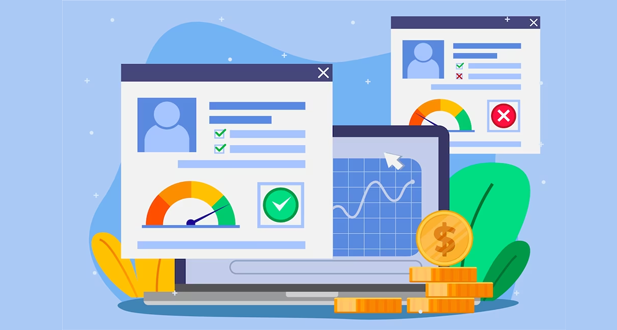The adoption of digitisation has been the slowest in the financial sector for loan management or lending solutions. Even though banking institutions have switched from Excel sheets to a digital record book, they still need a solution that would give them a full picture of how their products are doing, automate the steps of loan handling, and evaluate a person’s ability to pay back a loan in real-time.
What is Loan Management System?
The complete loan life cycle, including loan servicing, reporting, customer service, syndication, and customer tracking, can be automated and streamlined with the help of a loan management system, a digital tool that aids lenders.
It serves as a central data repository for the lenders, as a place to store all their financial records, create new loans, and manage client information. As a result, it provides a comprehensive summary of all the various steps in the lending lifetime.
This unified platform also includes analytical tools that can be used to generate thorough reports on cash flow as well as insightful analysis and insights into automating the complete lending cycle. In contrast to the conventional paper-based way of servicing debts, it offers a readily deployable and scalable comprehensive loan administration system.
Benefits of loan management system software
A business debt management system offers benefits in several ways. Let’s explore them further.
1. The removal of human mistake: There are many computations engaged in the lending ecosystem. Calculations vary from the EMI proportion to the loan payment amount depending on the borrower’s qualifications and length. Manually performing these computations in out-of-date lending software spreadsheets can result in errors. A loan administration system is designed to handle complicated calculations and immediately provide accurate valuations.
2. Saves effort: Since there are many stages and a lot of due research to be done, managing debt can be a time-consuming process. Using loan management software allows you to digitise all the papers and physical tasks, automating the repetitive tasks and freeing up the team’s time to concentrate on other business-related activities.
3. Creation of digital reports: A debt management system’s architecture should include automated reports that can be viewed in real-time. Investors, governmental agencies, and investors frequently request records like bookkeeping, invoices, and tax returns in the lending industry. These reports must be entirely correct and usually be filed in a shorter time. Now, these debt administration programs produce reports in favoured formats quickly and with the assurance of being highly accurate.
4. Gain a strategic advantage: Lenders can process applications, assign and oversee more loans, and have a complete overview from the loan application stage to their processing with loan processing software. With the assurance of a hacker- and error-proof mechanism, all of this. The product and IT teams now have time to focus on new lending product releases and improving client interactions, allowing them to acquire a competitive advantage.
5. Facilitate financing: An individual takes out loans very infrequently throughout their lives. Therefore, once they discover a loan institution that makes the process simple, they will likely continue using them. Businesses can speed up disbursal by simplifying the application process, automating the trustworthiness check, and using digitalised loan management software to generate loans.
Feature of Loan Management System
1. Scalability: Any company wanting to expand and build up needs the right tools. The ideal loan management system should enable lenders to expand their operations, provide outstanding customer service, and broaden the range of products they give. This allows lenders to boost their profit margins, expand into new markets, provide better solutions, and launch new goods more rapidly to meet the changing demands of developing markets. A scalable system assists in meeting the altered standards once a company has reached the development trajectory. The product’s scalability enables businesses to start modestly according to their needs.
2. Effortless implementation: Most start-ups and peer-to-peer financiers in this industry may need access to a specialised IT support. 24/7 access to an IT team is required to execute, manage, and troubleshoot problems emerging from such a sophisticated, data-critical technological solution. The good news is that most cloud-based debt management system service providers offer fast installation and routine upkeep services like bug fixes, frequent upgrades, and IT help when required.
3. An integrated approach: The banking industry has many aspects, including hiring, credit evaluation, loan origination, underwriting, disbursal, and payback. By speeding up turnaround times and being more effective, integrating all these components into a single piece of software enables lending companies to save time, process loan requests quickly, and provide clients with an overall positive experience. The best software for managing loans should let you combine customisable parts into a single, smooth, combined answer. The company benefits from support for integration with CRM, ERP, and bookkeeping software because it provides a uniform perspective and reduces time spent on reworking.
4. Centralized access: Lenders can keep all customer-related data in one place using loan management software solutions throughout the client lifecycle. They eliminate the bottleneck caused by storing and retrieving loan data from various platforms. Additionally, it enables the loan company to view the customer’s profile, the stage of lending they are in, their credit score, and all relevant information at a look from anywhere in the world.
5. Credit evaluation: The likelihood that lenders will choose interest rates and loan repayment conditions that reduce their risk and optimise revenues increases with the quality and accuracy of the credit evaluation. This is only feasible if the lenders comprehensively understand the debtors’ creditworthiness. Since the majority of start-ups and peer-to-peer lenders are interested in exploring developing markets where potential clients lack credit histories, they will need access to software that offers alternative credit rating techniques and databases, such as social media behaviour, utility bill payment behaviour, tax data, or bank statement analysis, to reduce risk and make well-informed decisions about things like interest rates and repayment terms.
6. Automated Process: Robotic process automation, also known as process automation or RPA, is very effective at automating repetitive chores, speeding up turnaround times and increasing organisational productivity. It accomplishes this by speeding up routine tasks like loan assessment and credit analysis, lowering application filing and clearance periods and minimising human error. Therefore, the ideal debt administration system should incorporate sufficient automatic and customisation capabilities.
7. Objectivity: For as long as anyone can remember, banks and financiers have never been particularly transparent. Modern lenders want to alter that by making their operations more transparent, giving all parties—including customers—a better understanding of and greater confidence in the loan process. Having an intuitive interface that updates clients on the state of their loan application at each stage will give them a better user experience than they have ever had with conventional banks.
8. A flexible interface: “Mobile-friendly” is no longer just used to describe webpages and applications. To boost usage and tap into new markets, tech firms are working to make their complex, bulky software mobile-friendly. This is crucial for modern lenders targeting developing markets where clients might not have access to desktop or laptop computers but almost definitely have smartphones or inexpensive tablets. As a result, having a mobile-friendly borrower or field staff UI is no longer an optional feature; it is now a feature you must seek in your loan management software system.
9. Insights and analytics: Best-in-class cloud-based debt administration tools give lenders gold in the shape of valuable data. Loan management software can provide lenders with professional insight into market trends, assist in establishing KPIs, improve customer acquisition, locate and eliminate blind spots and bottlenecks, and increase overall productivity by gathering, churning, and processing data from a variety of sources and applying business intelligence to this data pool.
10.Secure yet seamless: By establishing unified data storage that stakeholders can view with the proper rights from anywhere in the world, loan management software solutions enable lending organisations to expand and develop. It lessens the need for manual work, lowers the likelihood of human error, and speeds up procedures, increasing income. While providing the finest loan administration software available, ensure it complies with industry-established data security and privacy standards and follows best practices for data security.
Factors To Be Considered Before Choosing A Loan Management System
1. A broader scope: A loan management system that can be used for various purposes, such as mortgage paperwork, asset funding, business leasing, or consumer loans, must be looked into.
2. Convenient: No matter how simple or complicated a business’ requirements may be, it is crucial to have a simple loan management system to set up and configure to those needs.
3. A Centralized Approach: A good LMS ensures that all its loan application data is centralised into a comprehensive and single perspective for the loan section.
4. Quickness & Agility: An institution’s ability to approve and issue loans quickly is both a benefit to the organisation and a draw for customers.
5. Authenticated Access: The NBFCs prioritise the loan management system’s usability to approve loans and enable an effective business review and monitoring process. Financial institutions can obtain pertinent documents from third parties more quickly and without needless approvals by granting authorisation via credential-based access.
6. Support for technology and customer service: A robust loan management system provides the finest loan disbursement experience, improving the non-banking financial institution’s ability to provide excellent customer service.
7. Deployment via the Cloud or On-Premise: The finance industry dramatically benefits from cloud computing, increasing organisational effectiveness. It increases the financing procedure’s feasibility, productivity, efficiency, and affordability.
8. Greater Integration with Third Parties: A loan handling model must integrate with numerous other systems to give the team the most recent information.
9. Architecture Based on Microservices: A loan administration system built on microservices would guarantee that it is trustworthy, adaptable, and better suitable for loan sanctioning.
10. Support for Mobile and Web: In today’s mobile-driven market, application-based services are widespread on Android and iPhones and can be used by the banking sector to improve LMS effectiveness.
11. Always Secure the Operation: Through credential-based, safe cloud-based data management, one can streamline the complete administration of loans and all relevant papers because a lot of crucial information is just a click away.
12. Cost of Scalability: A lot of the tedious labour is removed with an LMS. All expenses associated with scaling up the product must be considered to obtain an accurate image of the ROI the product provides.
Selecting the right loan management software and frontend website for your business is a crucial decision that can significantly impact your operations, customer satisfaction, and overall efficiency. Here are some key points to consider when making this decision:
Loan Management Software
-
Understand Your Needs
- Assess the specific requirements of your loan business.
- Identify the types of loans you offer and their respective management needs.
- Determine the volume of transactions and user base the software needs to support.
-
Core Features
- Loan Origination: The software should facilitate the creation and processing of new loans.
- Underwriting: Look for tools that aid in assessing the creditworthiness of applicants.
- Servicing: Ensure the software can handle payments, interest calculations, and customer communications.
- Reporting: Robust reporting tools are essential for compliance and performance tracking.
- Collections: Efficient management of overdue loans and default risk.
-
Integration Capabilities
- Ensure the software can integrate with your existing systems (e.g., accounting, CRM, payment gateways).
- Look for APIs that allow seamless data exchange between different platforms.
-
Scalability
- The software should be able to grow with your business.
- Assess whether the system can handle an increase in loan volume and user activity without performance issues.
-
User Experience
- The interface should be intuitive and user-friendly.
- Consider software that offers a good user experience for both employees and customers.
-
Security
- Ensure the software complies with industry security standards.
- Look for features such as data encryption, multi-factor authentication, and regular security updates.
-
Compliance
- The software should help you stay compliant with local and international regulations.
- Look for tools that facilitate reporting and audits.
-
Vendor Support and Reputation
- Research the vendor’s reputation and customer reviews.
- Ensure they offer reliable customer support and regular updates.
-
Cost
- Consider the total cost of ownership, including initial setup, subscription fees, and any additional costs for upgrades or customizations.
- Compare the pricing models of different vendors to find the best value for your investment.
Frontend Website
-
Design and User Interface
- The website should have a clean, modern, and professional design.
- Ensure the layout is user-friendly and navigation is intuitive.
-
Responsiveness
- The website must be fully responsive, providing an optimal viewing experience across various devices (desktops, tablets, smartphones).
-
Speed and Performance
- Fast loading times are crucial for user satisfaction and SEO.
- Optimize images, scripts, and overall code to ensure quick page loads.
-
Content Management System (CMS)
- Choose a CMS that allows easy content updates and management.
- WordPress, Joomla, and Drupal are popular options with varying levels of customization.
-
SEO Optimization
- Ensure the website is optimized for search engines.
- Focus on meta tags, keyword integration, mobile-friendliness, and site architecture.
-
Security
- Implement SSL certificates for secure data transmission.
- Regularly update your CMS and plugins to patch vulnerabilities.
-
Integration with Loan Management Software
- Ensure seamless integration between the website and your loan management software.
- Look for features such as online loan applications, account management, and real-time updates.
-
Customer Portal
- Provide a secure portal where customers can log in, view their loan details, make payments, and communicate with your support team.
-
Analytics and Reporting
- Integrate tools like Google Analytics to track user behavior and website performance.
- Use data insights to make informed decisions and improve the user experience.
-
Customizability and Flexibility
- The website should be easy to customize to match your brand identity.
- Ensure it can adapt to changes in your business model or marketing strategies.
-
Support and Maintenance
- Choose a vendor or platform that offers reliable support and regular maintenance.
- Ensure there are provisions for technical support, troubleshooting, and regular updates.
-
Compliance and Accessibility
- Ensure the website complies with relevant regulations (e.g., GDPR for data protection).
- Make the site accessible to users with disabilities by following WCAG guidelines.
Final Thoughts
Choosing the best loan management software and frontend website involves careful consideration of your business needs, technical requirements, and customer expectations. By prioritizing these key points, you can make a well-informed decision that enhances your operational efficiency, boosts customer satisfaction, and supports your business growth. Always keep in mind the importance of scalability, security, user experience, and support in both your software and website choices.
Conclusion:
One can repay a bank loan according to their schedule, provided the payments are consistent and on time. Contrary to an overdraft, which deducts the whole amount of credit simultaneously. Alternatively, a consumer credit card does not allow the entire amount to be used simultaneously.
Frequently Asked Questions:
The whole loan lifetime is automated with the use of loan management systems. Depending on the needs, these programs can help in full or in part. The app can help with jobs like processing client information and making new loans. They can also give lenders open records and statements.
The complete loan life cycle, including loan servicing, reporting, customer service, syndication, and customer tracking, can be automated and streamlined with the help of a loan management system, a digital tool that aids lenders.
This loan monitoring software streamlined and automated the loan application, underwriting, approval, and related loan document management processes. In master credit files, automated pipeline reports keep track of the whole loan approval procedure.
A loan cycle is when a borrower seeks a loan and when it is repaid to the lender with interest.
Customers are issued loans using the loan processing API, which also keeps track of credit account data for billing and processing on the platform. The credit agreement is prepared, published, and communicated to the borrower and lender digitally when the credit has been approved.




